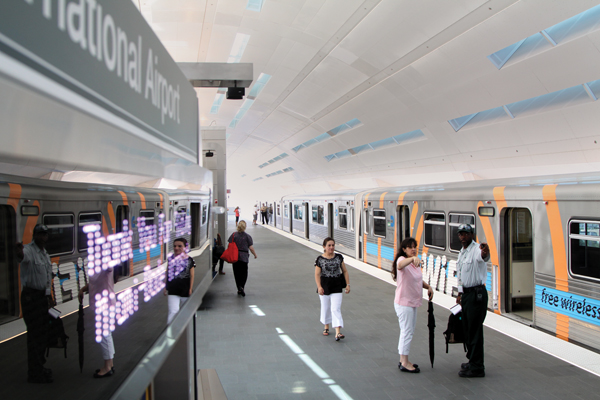
Meera Nagarsheth didn’t have a ride home from the airport at the end of winter break last year.
She arrived at Miami International Airport after a 22-hour flight, took a shuttle to the Tri-Rail, the Tri-Rail to the Metrorail and the Metrorail back to campus. It took her an hour and a half to travel eight miles.
“I had come from India, so I was jetlagged and had big bags,” said Nagarsheth, 20, a junior who spent her vacation visiting family and traveling. “Public transportation wasn’t the best option for me. I was tired and just wanted to get home.”
Today, however, students have the option of taking the 2.4-mile extension to the Metrorail from Miami International Airport.
The “AirportLink” extension, which opened at the end of July, connects the Earlington Heights station to a new public transportation center just northeast of the airport. Earlington Heights is 11 stops away from the University Metrorail station, the stop located across from the University of Miami’s Coral Gables campus on Ponce de Leon Boulevard.
Traveling to the airport from the University station takes approximately 30 minutes. Train service between Dadeland South and Earlington Heights stations has doubled in frequency, decreasing wait time.
Irene Ferradaz, a public information officer for Miami-Dade Transit, expects a 12-percent increase in ridership during the first year.
Ferradaz said the extension will help students because it “cuts down on hassles driving to the airport, wrestling with traffic, looking for a place to park and having to take a taxi.”
At the public transportation center, formally known as the Miami Intermodal Center, passengers will be able to connect to airport terminals via the Automated People Mover. The hub, which will open in the fall of 2013, will also provide access to the Tri-Rail, county buses, taxis and a rental car center.
UM alumnus Giovany Delgado, 23, rode the Metrorail every day for 10 years before he graduated in the spring. He plans to take advantage of the extension.
“Honestly, it’s about time they invested in a direct line to the airport,” he said. “Miami-Dade should continue investing in more lines to alleviate traffic.”
Political science professor George Gonzalez, whose research interests include urban sprawl and environmental politics, does not believe Miami is doing enough to develop a comprehensive mass transit system.
“Piecemeal projects, like the Metrorail airport extension, are ineffective in dealing with Miami’s automobile dependency and gridlock,” he said. “Miami, like other Sunbelt cities, are in desperate need of a comprehensive mass transit system, which covers much of the metro area. A high gasoline tax would move people, and housing and business development, toward that system.”
The $506-million extension is part of the larger People’s Transportation Plan (PTP), and is the first major extension since the Metrorail opened in 1984. In 2002, voters approved a half-penny sales tax increase to finance the PTP and, by extension, this project. The remaining $101.3 million was covered by the Florida Department of Transportation.
The PTP and its $17-billion budget also includes the plan to add more buses and routes, improve service, expand rapid transit and create thousands of transportation and construction-related jobs over the next 25 years, according to Ferradaz.
Despite the significant cost of construction, fares remain the same at $2 a ride.
The Metrorail runs from 5 a.m. to midnight, seven days a week. For a schedule, visit miamidade.gov/transit.





